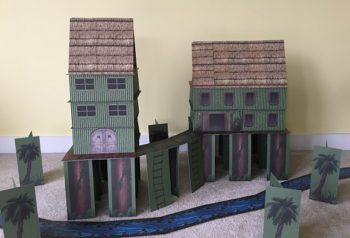
Obviously the whole notion of Kardtects is to build, and although these unique building cards can create Castles, Temples and Tombs, they are great at building the classic concept of card houses – namely houses.
Although houses round the world can vary distinctively, even into what rooms you could expect to find, one fundamental use that surely is universal is the concept of offering a safe place to sleep – commonly called a ‘Bedroom’.
Here are Twenty Top Facts about Beds and Bedrooms
- Before the English Georgian architecture, houses didn’t have corridors. Instead one room would lead to another and to another and so on. As such, with no corridors, a person may have to go through several bedrooms before they would get to their own, this is why the feature of ‘curtains’ were added to four poster beds, to add privacy for those pacing through a bedroom.
- The first recorded use of the word ‘Bedroom’ is found in William Shakespeare’s folio (although he used it to mean ‘room in bed’). Incidentally, when Shakespeare died he bequeathed his second best bed to his widow. His daughter got his best one. Beds for the middle class were extremely valuable, as much as one third of a family’s wealth might be tied up in the bed itself.
- Archaeologists studying the ancient people of Sibudu, in South Africa, have found evidence of bedding made from sedge grass dating back 77,000 years ago.
- The early history of an actual bed can be first found in ancient Egypt. Their beds look more like couches. Egyptians made no distinction between a night bed, or couch and a day bed; the same item is used for both sleeping and lounging. Pharaoh Tutankhamun’s bed was crafted from gold.
- In China, wooden beds were in use as early as 2,000 years ago (similar to those made in ancient Egypt). Even the four-poster bed is not unknown in China. At that time, Chinese beds were not very comfortable, with matting substituting for a mattress and their pillows were made from stone or wood, carved to fit the neck or head. Yet, the Chinese idea of heating stones then resting upon them during the night may have taken place during the Neolithic period. archaeologists think that these beds, called huoqiang, may have been used as long as 7,200 years ago.
- According to the principle of feng shui a bed should face directly in front of the door and having the foot of our bed in direct line with the door is called the “mortuary position”.
- The Japanese sleep on a bed called a tatami. This simple mat is spread out on the floor and in the morning, it is rolled up.
- Most people in the Mideast do not sleep on beds, but rather sleep on piles of rugs.
- The first waterbeds were actually invented by the Romans. The Romans would lie down in a bed of warm water and as they became drowsy, they were lifted onto a bed and rocked to sleep.
- The first coiled spring mattress was invented in 1871. The first mattresses were made of the pods that cover peas. As people began creating their mattresses, they became more and more fancy. Coverings of velvet and expensive silk were common among the wealthy. This could be the basis of the fairy-tale of the Princess and the Pea.
- A person typically spends a third of their life sleeping.
- The world’s most expensive bed is called Baldacchino Supreme, created by Stuart Hughes – one of the world’s most controversial designers. It costs more than $ 6.4 million.
- Because of his belief in the powers of magnetic flow, Charles Dickens always slept with his bed in a North-South alignment.
- In 396AD, St Augustine of Hippo mentioned a belief that you should go back to bed if anyone sneezes while you are putting your shoes on.
- The correct term for a fear of beds is ‘clinophobia’.
- The average bed has 5 million dust mites living in it.
- A 10-ounce pillow will double in weight in three years due to dust mites and dead skin. A mattress, after 8 years, will gain 10 pounds in dead skin.
- People produce 26 gallons of sweat in bed every year – makes you wonder about the invention of the water bed again.
- The world’s largest bed was 86ft 11in long and 53ft 11in wide and was made in the Netherlands in 2011.
- In the 1960’s a new change to the bed was introduced to America via England. It was a Scandinavian creation called the duvet and was brought to England by famed home goods retailer, Terrance Conrad, via his store, Habitat.
